

National Climate Assessment. Climate change, once considered an issue for a distant future, has moved firmly into the present.
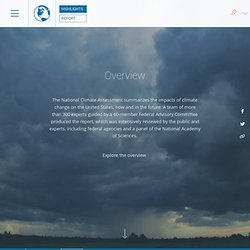
Corn producers in Iowa, oyster growers in Washington State, and maple syrup producers in Vermont are all observing climate-related changes that are outside of recent experience. So, too, are coastal planners in Florida, water managers in the arid Southwest, city dwellers from Phoenix to New York, and Native Peoples on tribal lands from Louisiana to Alaska. This National Climate Assessment concludes that the evidence of human-induced climate change continues to strengthen and that impacts are increasing across the country. Americans are noticing changes all around them.
Summers are longer and hotter, and extended periods of unusual heat last longer than any living American has ever experienced. Trees: A personal and national legacy of Evelyn's Sylva. 9 April 2014Last updated at 22:58 GMT By Mark Kinver Environment reporter, BBC News.
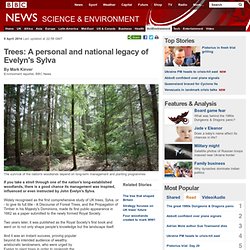
Potential climate engineering effectiveness and side effects during a high carbon dioxide-emission scenario : Nature Communications. Model trends during the RCP 8.5 climate change scenario The UVic model has recently been evaluated in several model intercomparison exercises9, 10, 11 and generally has a similar response to CO2 emission forcing as other models.
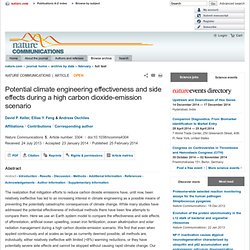
Here we will briefly mention how the results of our RCP 8.5 scenario control run (Supplementary Figs 1–3) compared with other models. We will also point out the trends that differ from other models since these (possible) biases need to be taken into consideration when evaluating the model’s response to climate engineering. For surface air temperature the model simulates a global mean warming of 3.1 °C by the year 2100 relative to a 1986–2005 reference period (see also Fig. 2c for warming relative to the pre-industrial period), which is within the ranges of an EMIC intercomparison (1.6–4.1 °C)10 and the CMIP5 models (2.5–5.0 °C)12.
Full size image (208 KB) Climate engineering method effects on temperature and CO2 Full size image (318 KB) Full size image (234 KB) BirdTrack Apps. Features *** Captures observations for UK and Ireland only ***Works without a network/WiFi connectionAdd casual recordsCreate complete and incomplete BirdTrack listsUse maps and GPS to get accurate location fixesDownload the full British and Irish species listSync all your existing BirdTrack sitesVerify all sightings against the local BirdTrack thresholdsUpload everything into your BirdTrack accountView what species have been seen in your local area over 3, 7 or 14 daysView local hotspots (~50 miles from device) over 3, 7 or 14 daysView your year and life listsView species you still need this year and lifeFull help within the app Basic instructions You can download the app free from both the Google Play Store and the Apple App Store.
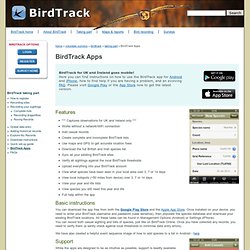
Once installed on your device, you need to enter your BirdTrack username and password (case sensitive), then populate the species database and download your existing BirdTrack locations. Death by sludge, coal and climate change for Great Barrier Reef? There's a phrase environmental scientists and campaigners like to use to talk about the slow and relentless degradation and destruction of habitats and natural wonders.

"Death by a thousand cuts", they call it, as small chunks of habitat are lost and environmental laws are eased or repealed. A bit of bush here for a tourism development, a stand of mangroves there for a beachside resort. An entire nature reserve for a coal mine. Sometimes, the threats come like pincer movements with all angles covered. For the Great Barrier Reef, though, the world's most famous and largest coral reef system, a final decision passed down today gives us another gash, through which could rush millions of tonnes of coal. The seven deadly sinners driving global warming - environment - 15 January 2014. IT'S a chart that no one wants to top, but global warming's worst offenders, in absolute terms, are the US, China, Russia, Brazil, India, Germany and the UK.
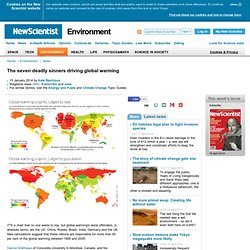
New calculations suggest that these nations are responsible for more than 60 per cent of the global warming between 1906 and 2005. Damon Matthews of Concordia University in Montreal, Canada, and his colleagues calculated national contributions to warming by weighting each type of emission according to the atmospheric lifetime of the temperature change it causes. Using historical data, they included carbon dioxide from burning fossil fuels and changes in land use – such as deforestation. The Sainsbury Laboratory. Let scientists keep the lab coat, goggles and pipette.

Playing a Facebook game as simple as Candy Crush is enough to take part in active research to help save the ash tree. In December 2012, scientists from The Sainsbury Laboratory hired Sheffield-based gaming company Team Cooper to develop "Fraxinus”. The game uses real genetic data from the fungus which causes Chalara ash dieback and from the common ash, Fraxinus excelsior. It involves matching and rearranging patterns of coloured leaf shapes which represent “nucleotides” – the letters that make up a genome sequence. People are better at this than computers alone, because the human eye can recognise patterns that computers miss. “Each play of the game will contribute a small but useful analysis,” said Dr Dan MacLean from The Sainsbury Laboratory who conceived the idea.